Evaluation Method for Underwater Ultrasonic Energy Radiation Performance Based on the Spatial Distribution Characteristics of Acoustic Power
Abstract
:1. Introduction
2. Methodology Principle
2.1. Evaluation Method of Underwater Ultrasonic Energy Radiation Performance Based on Acoustic Power Spatial Distribution Characteristics
2.1.1. Acoustic Wave Propagation Equations in Complex Impedance–Density Media Based on the Multi-Parameter Effects of the Underwater Environment
2.1.2. Sound Field Distribution Model
2.1.3. Sound Power Calculation Method
2.1.4. Sound Power in the Effective Radiant Area
2.1.5. Acoustic Energy Radiation Efficiency
2.2. Evaluation Method of Acoustic Energy Radiation Performance Based on Ultrasonic Transducer Array Modeling
2.2.1. Vibration Modeling of the Piezoelectric Transducer
2.2.2. Sound Pressure of the Transducer
2.2.3. Sound Pressure of the Array
2.2.4. Calculation of Sound Power
2.2.5. Acoustic Radiation Efficiency of the Underwater Ultrasonic Transducer Array
3. Design of the Experimental Simulation Model
4. Results and Discussion
4.1. Acoustic Radiation Power
4.2. Sound Power Analysis Based on a High-Resolution Spatial Distribution Model
4.3. Acoustic Radiation Angle
4.4. Acoustic Radiation Efficiency
4.5. Analysis of the Influence of the Underwater Environment on the Acoustic Energy Radiation Efficiency
5. Conclusions
Author Contributions
Funding
Institutional Review Board Statement
Informed Consent Statement
Data Availability Statement
Acknowledgments
Conflicts of Interest
References
- Zereik, E.; Bibuli, M.; Mišković, N.; Ridao, P.; Pascoal, A. Challenges and future trends in marine robotics. Annu. Rev. Control 2018, 46, 350–368. [Google Scholar] [CrossRef]
- Jouhari, M.; Ibrahimi, K.; Tembine, H.; Ben-Othman, J. Underwater wireless sensor networks: A survey on enabling technologies, localization protocols, and internet of underwater things. IEEE Access 2019, 7, 96879–96899. [Google Scholar] [CrossRef]
- Zhang, C.; Lin, X.J.; Zhang, X.; Yang, F.; Huang, S.F. Planar acoustic transducer and underwater ultrasonic wireless energy transmission. J. Mater. Sci. Mater. Electron. 2022, 33, 10504–10515. [Google Scholar] [CrossRef]
- Liu, Z.; Zhang, T.; Geng, Y.; An, T. Underwater Wireless High-Efficiency Energy Transmission Method Based on the Ultrasonic Transducer Array. In Proceedings of the 2021 IEEE 21st International Conference on Communication Technology (ICCT), Tianjin, China, 13–16 October 2021; IEEE: Piscataway, NJ, USA, 2021. [Google Scholar]
- Ensminger, D.; Bond, L.J. Ultrasonics: Fundamentals, Technologies, and Applications; CRC Press: Boca Raton, FL, USA, 2024. [Google Scholar]
- Mohsan SA, H.; Khan, M.A.; Mazinani, A.; Alsharif, M.H.; Cho, H. Enabling underwater wireless power transfer towards sixth generation (6G) wireless networks: Opportunities, recent advances, and technical challenges. J. Mar. Sci. Eng. 2022, 10, 1282. [Google Scholar] [CrossRef]
- Zhang, B.; Xu, W.; Lu, C.; Lu, Y.; Wang, X. Review of low-loss wireless power transfer methods for autonomous underwater vehicles. IET Power Electron. 2022, 15, 775–788. [Google Scholar] [CrossRef]
- Yu, L.; Sun, H.; Su, S.; Tang, H.; Sun, H.; Zhang, X. Review of Crucial Problems of Underwater Wireless Power Transmission. Electronics 2022, 12, 163. [Google Scholar] [CrossRef]
- Ali, M.F.; Jayakody, D.N.K.; Chursin, Y.A.; Affes, S.; Dmitry, S. Recent Advances and Future Directions on Underwater Wireless Communications. Arch. Comput. Methods Eng. 2020, 27, 1379–1412. [Google Scholar] [CrossRef]
- Malyarenko, E.V.; Heyman, J.S.; Chen-Mayer, H.H.; Tosh, R.E. Time-resolved radiation beam profiles in water obtained by ultrasonic tomography. Metrologia 2010, 47, 208. [Google Scholar] [CrossRef]
- Koda, T.; Mitome, H.; Shibata, S. An Underwater FM Ultrasonic Homing System. In Proceedings of the IEEE 1984 Ultrasonics Symposium, Dallas, TX, USA, 14–16 November 1984; IEEE: Piscataway, NJ, USA, 1984. [Google Scholar]
- Rogers, D.L. Comparison of the Spatial Distributions of Cavitation Damage with the Measured Diffraction Patterns for a High-Power Ultrasonic Transducer. Bachelor’s Thesis, The University of Mississippi, Oxford, MS, USA, 2015. [Google Scholar]
- Koosha, A. Ultrasonic Transducers for Air and Underwater Communication. Ph.D. Thesis, Kingston University, London, UK, 1993; p. 1534. [Google Scholar]
- Pranitha, B.; Anjaneyulu, L. Analysis of underwater acoustic communication system using equalization technique for ISI reduction. Procedia Comput. Sci. 2020, 167, 1128–1138. [Google Scholar] [CrossRef]
- Orekan, T.; Zhang, P.; Shih, C. Analysis, design, and maximum power-efficiency tracking for undersea wireless power transfer. IEEE J. Emerg. Sel. Top. Power Electron. 2017, 6, 843–854. [Google Scholar] [CrossRef]
- Guida, R.; Demirors, E.; Dave, N.; Melodia, T. Underwater ultrasonic wireless power transfer: A battery-less platform for the internet of underwater Things. IEEE Trans. Mob. Comput. 2020, 21, 1861–1873. [Google Scholar] [CrossRef]
- Kuperman, W.; Roux, P. Underwater acoustics. In Springer Handbook of Acoustics; Springer: Berlin/Heidelberg, Germany, 2007; pp. 149–204. [Google Scholar]
- Zhao, X.; Pompili, D.; Alves, J. Underwater acoustic carrier aggregation: Achievable rate and energy-efficiency evaluation. IEEE J. Ocean. Eng. 2017, 42, 1035–1048. [Google Scholar] [CrossRef]
- Hoyle, B.S.; Xu, L.A. Ultrasonic Sensors; Butterworth-Heinemann: Oxford, UK, 1995. [Google Scholar]
- Islam, K.Y.; Ahmad, I.; Habibi, D.; Waqar, A. A survey on energy efficiency in underwater wireless communications. J. Netw. Comput. Appl. 2022, 198, 103295. [Google Scholar] [CrossRef]
- Wibisono, A.; Alsharif, M.H.; Song, H.-K.; Lee, B.M. A survey on underwater wireless power and data transfer system. IEEE Access 2024, 12, 34942–34957. [Google Scholar] [CrossRef]
- Beranek, L.L.; Mellow, T.J. Acoustics: Sound Fields and Transducers; Academic Press: Cambridge, MA, USA, 2012. [Google Scholar]
- Wang, B.; Zhao, Z.; Lu, Z.; Hu, A.; Zhang, L. Highly directional acoustic array backward radiation suppression and optimization method. Chin. J. Sci. Instrum. 2022, 43, 302–311. [Google Scholar]
- Hoshi, T.; Takahashi, M.; Iwamoto, T.; Shinoda, H. Noncontact tactile display based on radiation pressure of airborne ultrasound. IEEE Trans. Haptics 2010, 3, 155–165. [Google Scholar] [CrossRef]
- Fahy, F.; Gardonio, P. Sound and Structural Vibration: Radiation, Transmission and Response; Elsevier: Amsterdam, The Netherlands, 2007. [Google Scholar]
- Xu, H.; Li, Q.; Tang, R.; Shang, D. Method for measuring the low-frequency sound power from a complex sound source based on sound-field correction in a non-anechoic tank. Chin. Phys. B 2023, 32, 054303. [Google Scholar] [CrossRef]
- Trefry, M.G.; Bekele, E. Structural characterization of an island aquifer via tidal methods. Water Resour. Res. 2004, 40. [Google Scholar] [CrossRef]
- Larsen, O.N.; Radford, C. Acoustic conditions affecting sound communication in air and underwater. In Effects of Anthropogenic Noise on Animals; Springer: Berlin/Heidelberg, Germany, 2018; pp. 109–144. [Google Scholar]
- Elliott, S.J.; Johnson, M.E. Radiation modes and the active control of sound power. J. Acoust. Soc. Am. 1993, 94, 2194–2204. [Google Scholar] [CrossRef]
- Stojanovic, M.; Preisig, J. Underwater acoustic communication channels: Propagation models and statistical characterization. IEEE Commun. Mag. 2009, 47, 84–89. [Google Scholar] [CrossRef]
- Ahmed Alanazi, M.; Ali, I. Simulations and analysis of underwater acoustic wave propagation model based on Helmholtz equation. Appl. Math. Sci. Eng. 2024, 32, 2338397. [Google Scholar] [CrossRef]
- Sheng, X.; Hu, Y.-H. Maximum likelihood multiple-source localization using acoustic energy measurements with wireless sensor networks. IEEE Trans. Signal Process. 2004, 53, 44–53. [Google Scholar] [CrossRef]
- Siddique, A.R.M.; Mahmud, S.; Van Heyst, B. A comprehensive review on vibration based micro power generators using electromagnetic and piezoelectric transducer mechanisms. Energy Convers. Manag. 2015, 106, 728–747. [Google Scholar] [CrossRef]
- Ahmed, R.; Mir, F.; Banerjee, S. A review on energy harvesting approaches for renewable energies from ambient vibrations and acoustic waves using piezoelectricity. Smart Mater. Struct. 2017, 26, 085031. [Google Scholar] [CrossRef]
- Koopmann, G.H.; Song, L.; Fahnline, J.B. A method for computing acoustic fields based on the principle of wave superposition. J. Acoust. Soc. Am. 1989, 86, 2433–2438. [Google Scholar] [CrossRef]
- Sayin, U.; Artís, P.; Guasch, O. Realization of an omnidirectional source of sound using parametric loudspeakers. J. Acoust. Soc. Am. 2013, 134, 1899–1907. [Google Scholar] [CrossRef] [PubMed]
- Wu, Y.; Shao, S.; Che, D. Fast and low grating lobe multi-beam steering with a subarray level unequally spaced optical phased array. J. Opt. Soc. Am. B 2021, 38, 3417–3424. [Google Scholar] [CrossRef]
- Ohkawa, K. Confirmation of the Biot theory for water-saturated sands at high frequencies and effects of scattering on the attenuation of sound waves. J. Acoust. Soc. Am. 2006, 119, 709–711. [Google Scholar] [CrossRef]
- Ahmad, S. A Linear Array Design Based on Non-Uniform Chebyshev Distribution for High Gain Low Sidelobe Level Millimetre Wave 5G Applications. Master’s Thesis, Universitat Politècnica de Catalunya, Barcelona, Spain, 2020. [Google Scholar]
- Cremer, L.; Heckl, M. Structure-Borne Sound: Structural Vibrations and Sound Radiation at Audio Frequencies; Springer Science & Business Media: Berlin/Heidelberg, Germany, 2013. [Google Scholar]
- Holland, K.R. Principles of sound radiation. In Loudspeaker and Headphone Handbook; Routledge: London, UK, 2012; pp. 1–43. [Google Scholar]
- Larsen, O.N.; Wahlberg, M.; Brown, C.; Riede, T. Sound and sound sources. In Comparative Bioacoustics: An Overview; Bentham Science Publishers: Sharjah, United Arab Emirates, 2017; pp. 3–60. [Google Scholar]

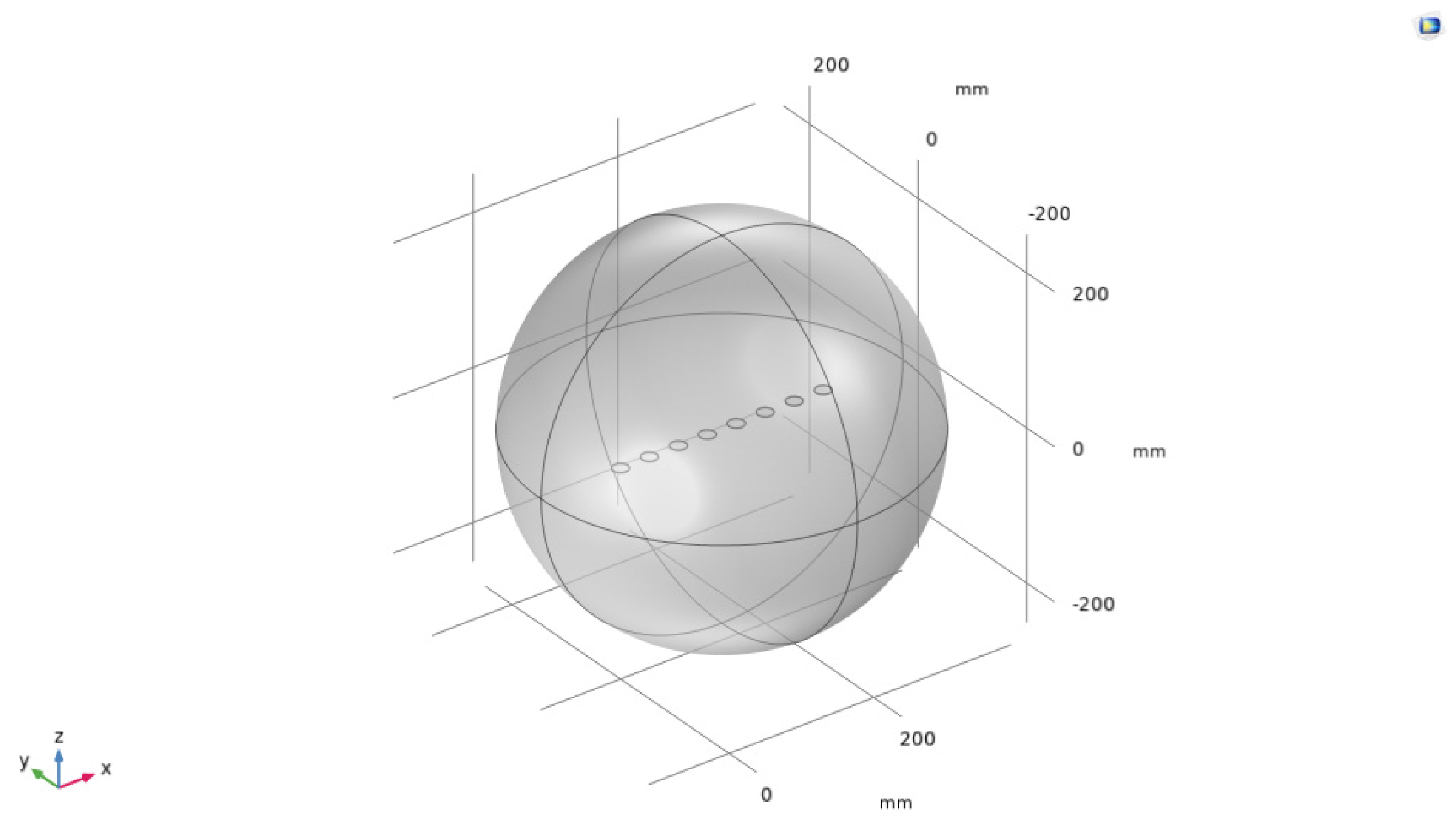


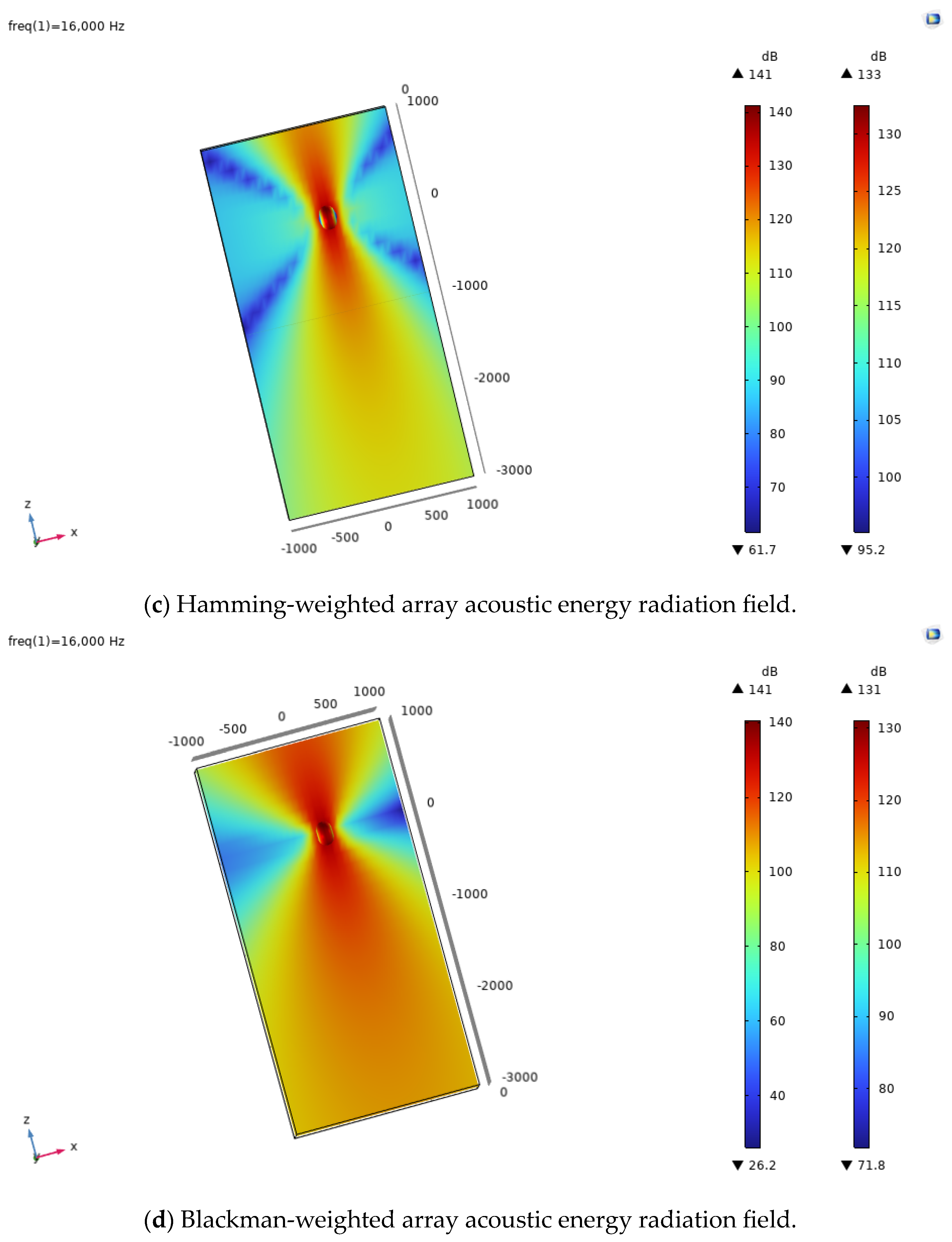





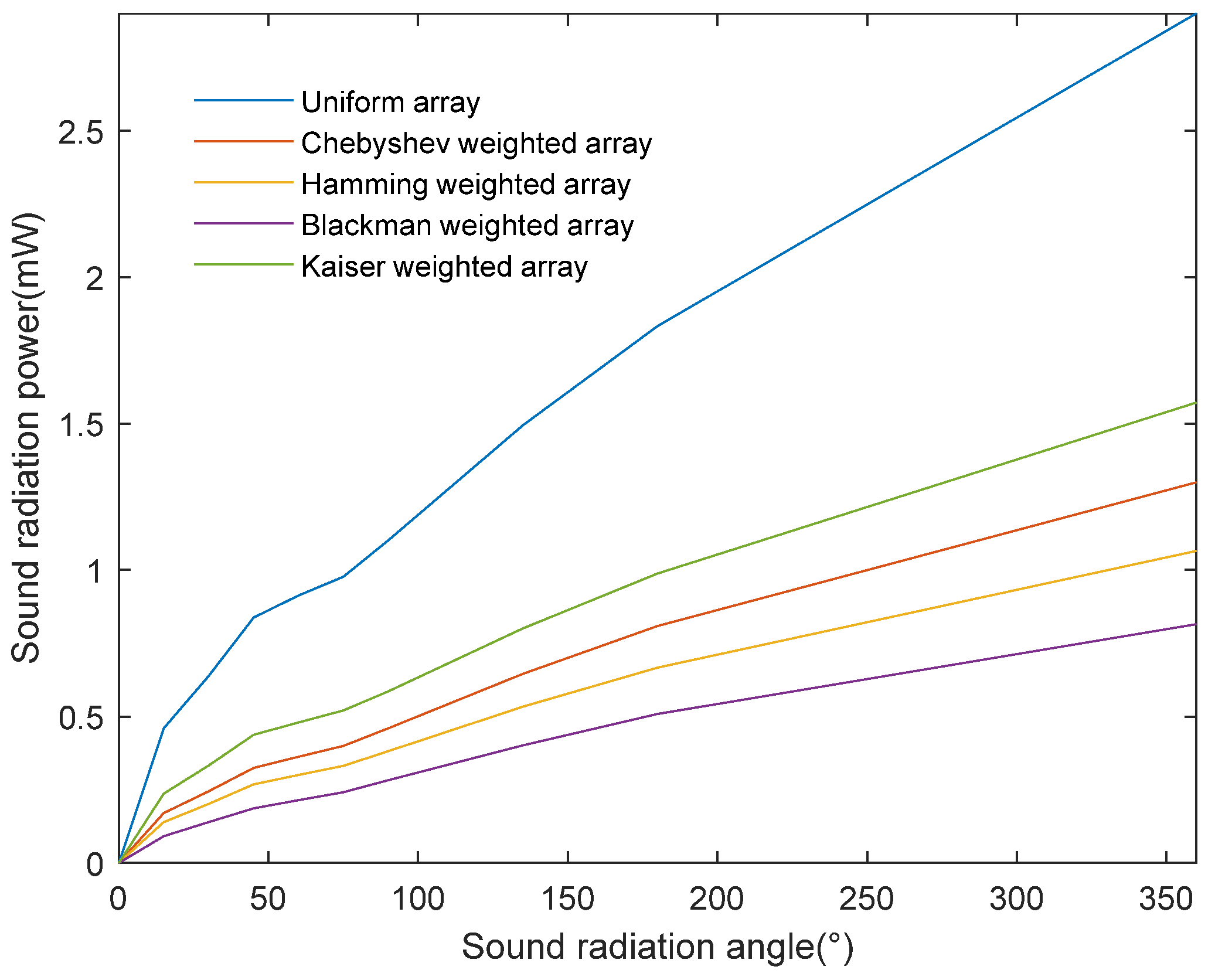
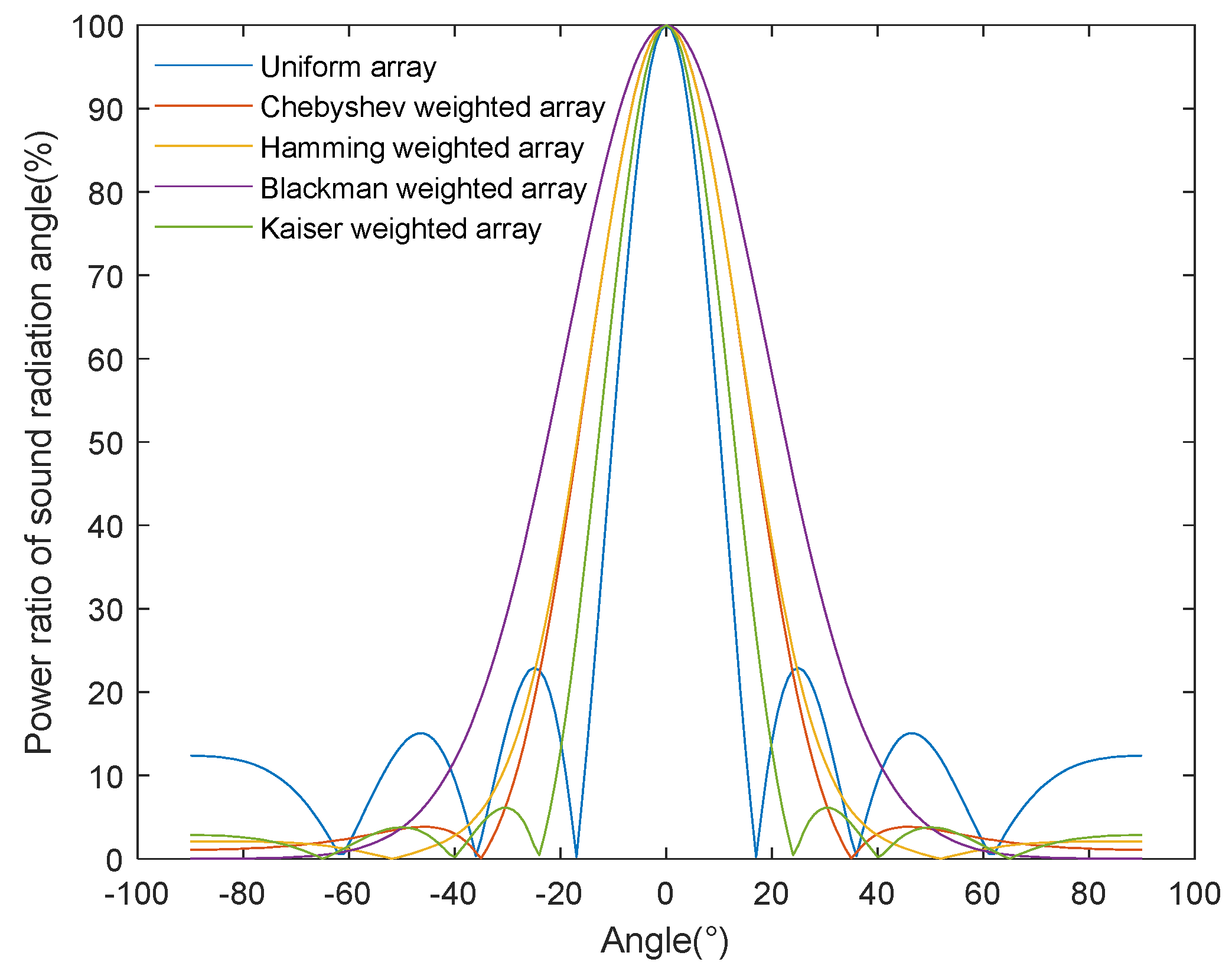
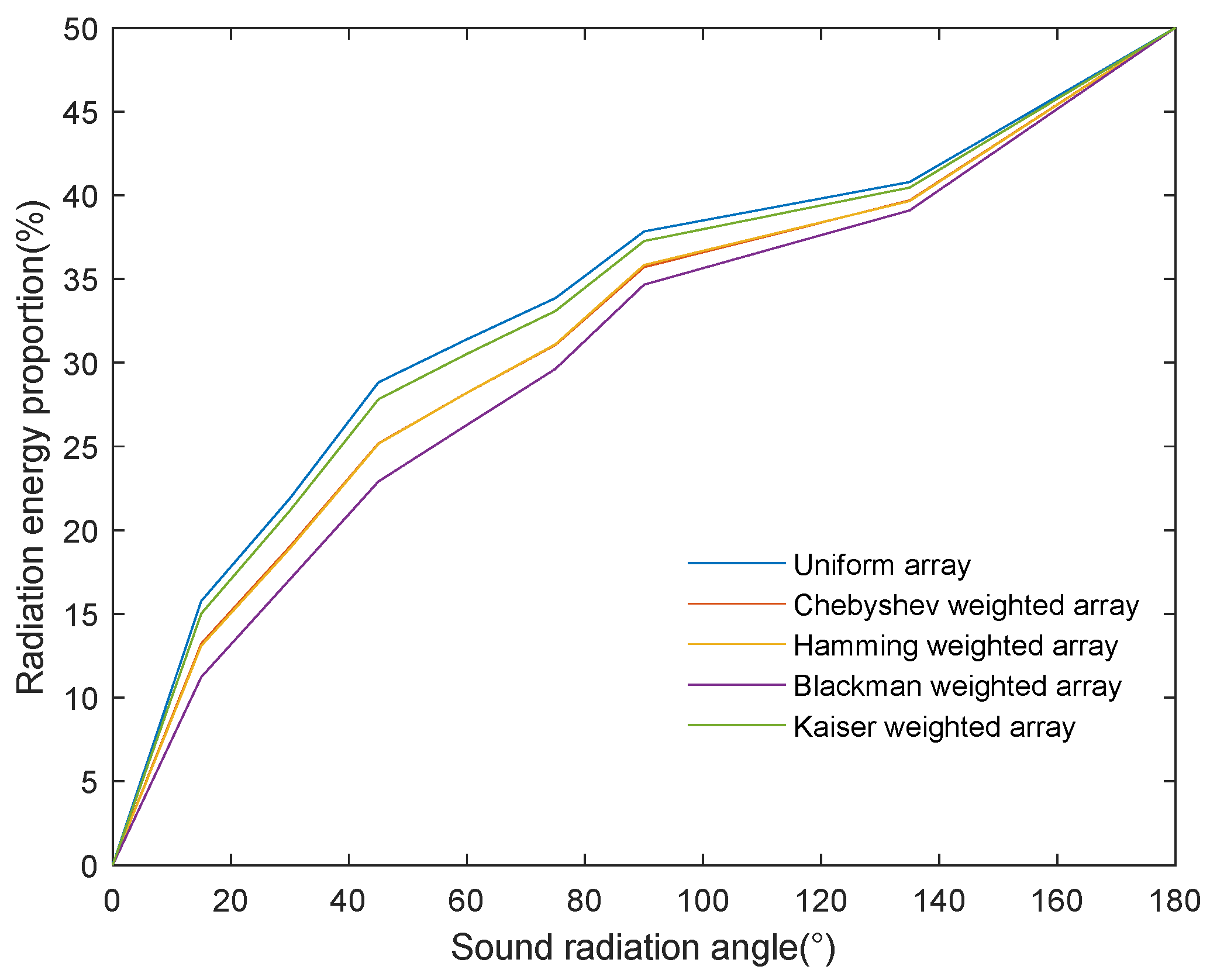


| Symbol | Model Parameter | Parameter Value |
|---|---|---|
| Volume of free-space water | 2 × 2 × 4 m | |
| N | Number of array elements | 8 |
| a | Radius of piezoelectric ring | 1 cm |
| h | Thickness of piezoelectric ring | 1 mm |
| d | Array element spacing | 4 cm |
| T | Temperature of water medium | 277.15 K, 293.15 K, and 313.15 K |
| Reference temperature of water medium | 273.15 K | |
| Salinity of water medium | 35 | |
| pH | pH of water medium | 8 |
| Rated drive voltage | 10 V | |
| Piezoelectric constant | 500 pC/N | |
| Radiation power sphere radius | 15, 25, 35, 45, 75, 100, 150, 200, 250, and 300 cm |
| Array Type | Relative Accuracy |
|---|---|
| Uniform array | 42.6721% |
| Chebyshev-weighted array | 49.0047% |
| Hamming-weighted array | 49.0052% |
| Blackman-weighted array | 51.9048% |
| Kaiser-weighted array | 47.2426% |
Disclaimer/Publisher’s Note: The statements, opinions and data contained in all publications are solely those of the individual author(s) and contributor(s) and not of MDPI and/or the editor(s). MDPI and/or the editor(s) disclaim responsibility for any injury to people or property resulting from any ideas, methods, instructions or products referred to in the content. |
© 2024 by the authors. Licensee MDPI, Basel, Switzerland. This article is an open access article distributed under the terms and conditions of the Creative Commons Attribution (CC BY) license (https://creativecommons.org/licenses/by/4.0/).
Share and Cite
Liu, Z.; Zhang, T.; Yuan, Y.; Li, Y.; Geng, Y. Evaluation Method for Underwater Ultrasonic Energy Radiation Performance Based on the Spatial Distribution Characteristics of Acoustic Power. Sensors 2024, 24, 3942. https://doi.org/10.3390/s24123942
Liu Z, Zhang T, Yuan Y, Li Y, Geng Y. Evaluation Method for Underwater Ultrasonic Energy Radiation Performance Based on the Spatial Distribution Characteristics of Acoustic Power. Sensors. 2024; 24(12):3942. https://doi.org/10.3390/s24123942
Chicago/Turabian StyleLiu, Zhongzheng, Tao Zhang, Yazhen Yuan, Yuhang Li, and Yanzhang Geng. 2024. "Evaluation Method for Underwater Ultrasonic Energy Radiation Performance Based on the Spatial Distribution Characteristics of Acoustic Power" Sensors 24, no. 12: 3942. https://doi.org/10.3390/s24123942





